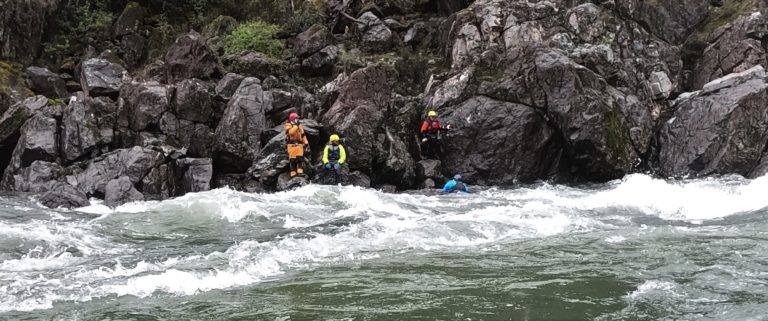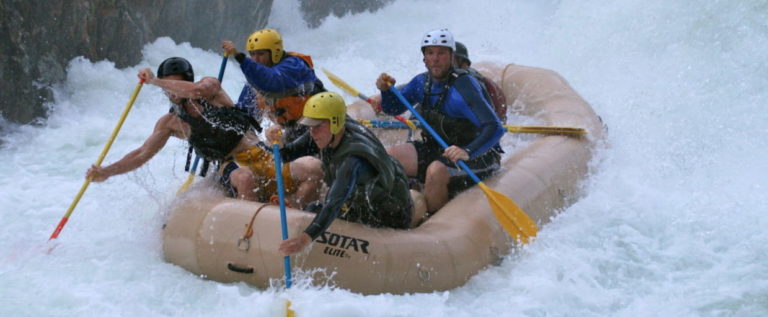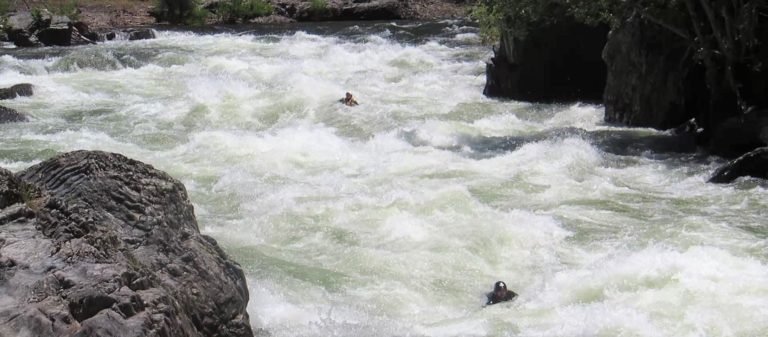When I started guiding in the early 1990’s we were still using bucket boats. Once those rafts wrapped (and they did so much more often than self-bailers), they were extremely challenging to remove from a rock.
Luckily the stiffer hypalon and polyurethane self-bailing rafts don’t wrap nearly as often (they flip more!) as the old hypalon bucket rafts. However many people still treat wraps like their rafts are bucket boats. In this article we will review some basics about preventing wraps and simple ways of getting your self-bailing raft off a rock.
How to Prevent a Wrap
The best way to unwrap a raft is to not wrap it in the first place. Make sure your raft is properly rigged, train your paddle crew, be willing to scout and read up on the section of river you are going to run. Here are a few more tips to avoid wrapping.
Avoid the Rock (Particularly with the broadside)
- The best option is to not come in contact with the rock. Plan ahead, look downstream, make a decision early to go left or right.
- Bow or Stern First
If you are going to hit the rock, hit it with you bow or stern. Most wraps happen when the side of a raft broadsides a rock. As the end of you raft hits the rock pivot your boat off the rock.
Call an Early Over (High-Side)
If you are going to hit a rock sideways call an over BEFORE the raft hits the rock. Calling an over (high-side) early is the best way to avoid a wrap. Also, having trained your crew and practiced doing high-side prior to needing to use it will increase the probability of success greatly.
Videos on Overs (High-sides)
In the first video below watch how the raft hits the rock and then the upstream tube begins to submerge. If the crew had over-righted before the raft hit the rock the left tube would have most likely never submerged.
Early Over
In the next video listen as the guide calls a “high-side left” (over-left) before the raft hits the rock and the crew de-weights the upstream tube preventing a wrap or flip. Also important is that the guide has the crew stay left until they are passed the rock.
The Physics of a Wrapped Raft
Rafts want to float and move with the river downstream. A boat stuck on a rock is there because forces are keeping it underwater and from continuing downstream. It’s best to try to find ways to reduce those restrictive forces rather than add additional forces to the mix. People who have the most success in unwrapping boats take time to see which side of the rock the raft wants to go around.
Forces holding a pinned raft in place.
1. Force of the river coming down over a drop. This force is countered by the raft wanting to float on the surface.
2. Friction between the raft and the rock. Due to downstream current and the weight of people and gear on the raft. This force is working against the river taking the raft around one side of the rock or the raft getting pushed up on top of the rock.
Dealing With a Wrap
More important than unwrapping your raft is not making things worse. typically once a raft has wrapped it is a static environment. Take a breath and look around. Give time for the other rafts in your group to station themselves so that if someone falls in the river they can be picked up. Ideally there is someone upstream letting other groups know that you are blocking part of the river. Have a plan for when the raft comes off before starting to try to unwrap it.
Start Simple
Look at how the raft is being held in place. Look for a way to DECREASE the forces on the raft to allow it to float up or around one side of the rock. The easiest way is to push and pull on the raft.
- Pull on Handles
Try pulling up on a handle. If possible first on the side of the rock where you think the raft will NOT go. By pulling up on that side you decrease the force on that side and potentially allow the river to take the raft around the other side of the rock. - If that doesn’t work try pulling on the other handle. Get your friends on the rock to give you a hand.
- Try pushing the top tube away from the rock (back upstream) to flip the raft upside down.
Video of Flipping a Raft Away from the Rock
Short Lines
Depending upon the situation it may be helpful to clip a flip line to the raft and pull up. Try pulling from different spots. Get multiple people involved in pulling. Start on the side of the raft that is less likely to go around the rock.
Video of Using a Flip Line to Help Unpin a Raft
In the video below notice that initially (4:00) the guide is pulling up on the side of the raft that is on the side of the rock where most of the current is (and where the raft wants to go). He is working against the river and having no success.
At the 5:00 minute mark he clips the throw bag in a better spot to pull up and reduce the friction between the raft and the river bed. It would probably be even better if he clipped on the boat a little farther to the river right end of the raft.
At 13:00 minutes with the help of a few other people he is able to get the raft off to the left of the rock. The rescue didn’t require any complicated rope systems and they were able to keep the raft at the rock so no one was stranded. They also deflated the thwarts at one point. I’m not sure if this helped however tube deflation is a useful trick that might have helped with the top river right tube. We will discuss tube deflation next.
Tube Delation
There is a side of the rock that the raft wants to go around more than the other. The premise is similar to pulling a tube out of the water. Deflating a tube reduces the force of the river on a tube and sometimes allows the tube that was under water to float to the surface due to the top tube being softer. This allows the raft to spin off the other side of the rock.
Avoid deflating tubes that are underwater. Do not deflate the floor. Inflated tubes that are underwater provide force to bring the raft to the surface and helping the raft come off the rock.
Be weary of valves that could fill with water if too much air is let out of a tube. Be patient with the deflation and be willing to let a fair amount of air out of tubes that are out of the water and pinned against rocks.
Rope from Shore
Before getting into ropes it is best to have taken some training through a guide school and/or swiftwater rescue course. The opportunity to injury someone increases dramatically when people start pulling on ropes particularly with mechanical advantage system.
While it is rare to need to use ropes from shore. Having comfort and regular practice use ropes will allow you to use them when needed. We will do a separate article just on using ropes from shore since it is complicated and we cannot cover it in the depth it needs to be here. For the moment check out this commentary on z-rigs.
Concluding Thoughts
In the early 2000’s I had the opportunity to work on the Tuolumne River outside Yosemite. Wrapped rafts were a regular occurrence on these trips. About the same time I first heard about deflating tubes to unwrap rafts. Over the next few years we dealt with around 75 wraps that needed more than the simple pulling on a tube. All (including many gear boats) but two were fixed with tube deflation.
While knots and ropes are fun, they are rarely necessary to unwrap or unpin a raft. Many people jump to ropes from shore with a mechanical advantage too quickly. I have seen and heard about way more injuries from using mechanical advantage systems than from using in-raft techniques. While mechanical advantage has its place if you are using it most likely there is a way get the same result with less force.


